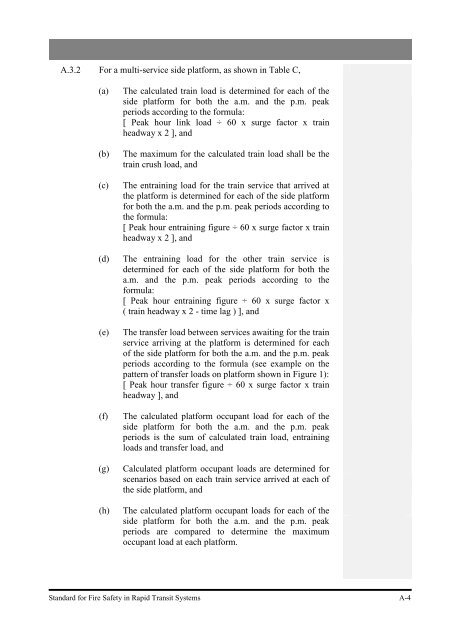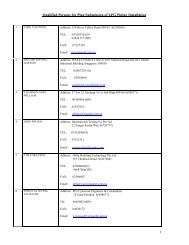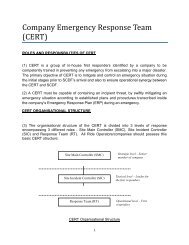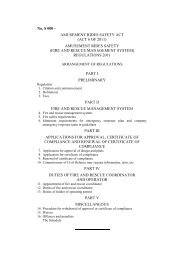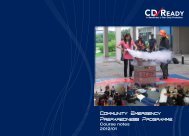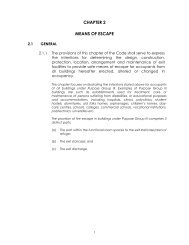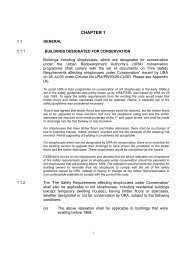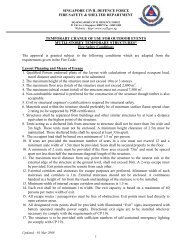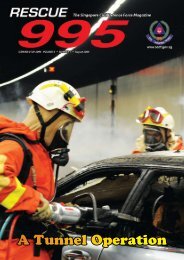Standard for Fire Safety in Rapid Transit Systems - Singapore Civil ...
Standard for Fire Safety in Rapid Transit Systems - Singapore Civil ...
Standard for Fire Safety in Rapid Transit Systems - Singapore Civil ...
You also want an ePaper? Increase the reach of your titles
YUMPU automatically turns print PDFs into web optimized ePapers that Google loves.
A.3.2 For a multi-service side plat<strong>for</strong>m, as shown <strong>in</strong> Table C,<br />
(a) The calculated tra<strong>in</strong> load is determ<strong>in</strong>ed <strong>for</strong> each of the<br />
side plat<strong>for</strong>m <strong>for</strong> both the a.m. and the p.m. peak<br />
periods accord<strong>in</strong>g to the <strong>for</strong>mula:<br />
[ Peak hour l<strong>in</strong>k load ÷ 60 x surge factor x tra<strong>in</strong><br />
headway x 2 ], and<br />
(b) The maximum <strong>for</strong> the calculated tra<strong>in</strong> load shall be the<br />
tra<strong>in</strong> crush load, and<br />
(c) The entra<strong>in</strong><strong>in</strong>g load <strong>for</strong> the tra<strong>in</strong> service that arrived at<br />
the plat<strong>for</strong>m is determ<strong>in</strong>ed <strong>for</strong> each of the side plat<strong>for</strong>m<br />
<strong>for</strong> both the a.m. and the p.m. peak periods accord<strong>in</strong>g to<br />
the <strong>for</strong>mula:<br />
[ Peak hour entra<strong>in</strong><strong>in</strong>g figure ÷ 60 x surge factor x tra<strong>in</strong><br />
headway x 2 ], and<br />
(d) The entra<strong>in</strong><strong>in</strong>g load <strong>for</strong> the other tra<strong>in</strong> service is<br />
determ<strong>in</strong>ed <strong>for</strong> each of the side plat<strong>for</strong>m <strong>for</strong> both the<br />
a.m. and the p.m. peak periods accord<strong>in</strong>g to the<br />
<strong>for</strong>mula:<br />
[ Peak hour entra<strong>in</strong><strong>in</strong>g figure ÷ 60 x surge factor x<br />
( tra<strong>in</strong> headway x 2 - time lag ) ], and<br />
(e) The transfer load between services await<strong>in</strong>g <strong>for</strong> the tra<strong>in</strong><br />
service arriv<strong>in</strong>g at the plat<strong>for</strong>m is determ<strong>in</strong>ed <strong>for</strong> each<br />
of the side plat<strong>for</strong>m <strong>for</strong> both the a.m. and the p.m. peak<br />
periods accord<strong>in</strong>g to the <strong>for</strong>mula (see example on the<br />
pattern of transfer loads on plat<strong>for</strong>m shown <strong>in</strong> Figure 1):<br />
[ Peak hour transfer figure ÷ 60 x surge factor x tra<strong>in</strong><br />
headway ], and<br />
(f) The calculated plat<strong>for</strong>m occupant load <strong>for</strong> each of the<br />
side plat<strong>for</strong>m <strong>for</strong> both the a.m. and the p.m. peak<br />
periods is the sum of calculated tra<strong>in</strong> load, entra<strong>in</strong><strong>in</strong>g<br />
loads and transfer load, and<br />
(g) Calculated plat<strong>for</strong>m occupant loads are determ<strong>in</strong>ed <strong>for</strong><br />
scenarios based on each tra<strong>in</strong> service arrived at each of<br />
the side plat<strong>for</strong>m, and<br />
(h) The calculated plat<strong>for</strong>m occupant loads <strong>for</strong> each of the<br />
side plat<strong>for</strong>m <strong>for</strong> both the a.m. and the p.m. peak<br />
periods are compared to determ<strong>in</strong>e the maximum<br />
occupant load at each plat<strong>for</strong>m.<br />
<strong>Standard</strong> <strong>for</strong> <strong>Fire</strong> <strong>Safety</strong> <strong>in</strong> <strong>Rapid</strong> <strong>Transit</strong> <strong>Systems</strong> A-4


